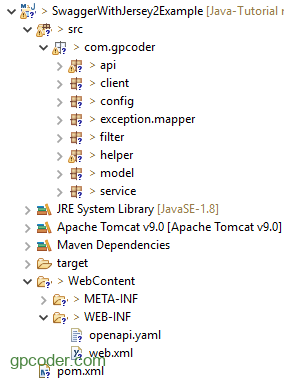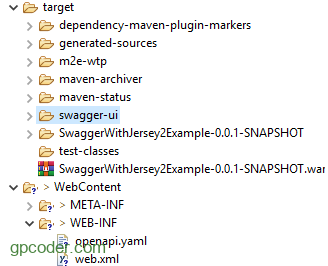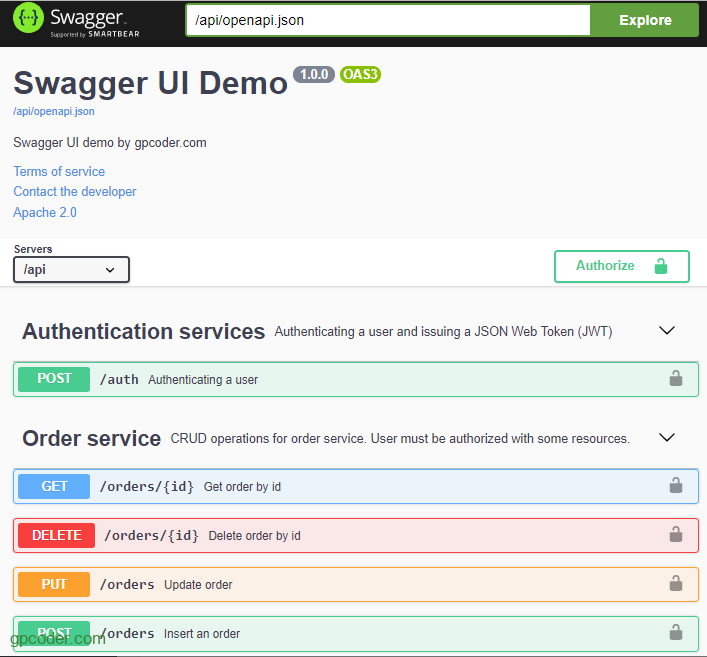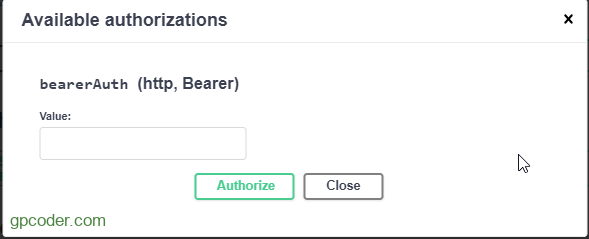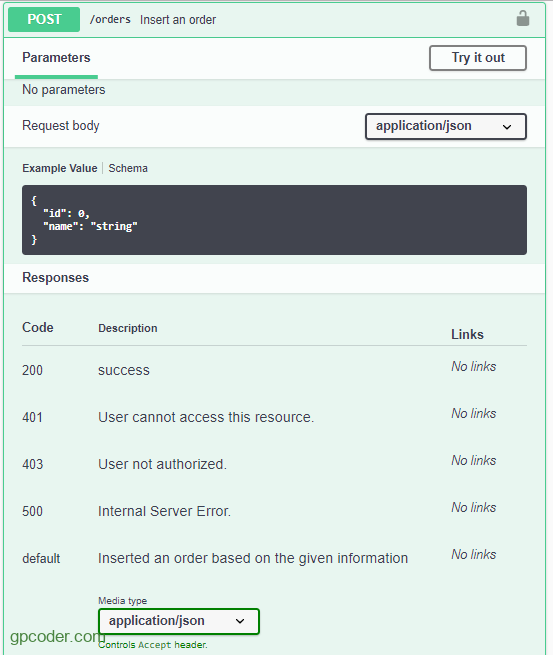Sử dụng Swagger UI trong jersey REST WS project

Bài viết được sự cho phép của tác giả Giang Phan
Trong các bài viết trước, tôi đã giới thiệu với các bạn Swagger và cách cài đặt, sử dụng Swagger UI. Trong thực tế, các API thường được thay đổi bởi các developer và họ ít khi mở Swagger editor để cập nhật lại các document hoặc vì lý do nào đó mà họ không cập nhật document mới nhất theo source code. Một vấn đề đặt ra là có cách nào để API document có thể cập nhật một cách tự động mỗi khi code thay đổi và đặt cùng một nơi trong code để developer dễ dàng cập nhật hay không? Câu trả là là có và tôi sẽ hướng dẫn các bạn thực hiện trong phần tiếp theo của bài viết này.
Xem thêm việc làm Linux lương cao trên Station D
Tích hợp JAX-RS REST project với Swagger UI để tạo API document một cách tự động
Tiếp tục bài viết về xây dựng RESTful API với Jersey, trong bài này tôi sẽ hướng dẫn các bạn cách tích hợp JAX-RS REST project với Swagger UI để tạo API document một cách tự động. Nếu các bạn làm Spring project có thể tìm hiểu về Springfox – đây là một thư viện rất mạnh mẽ và dễ sử dụng để tạo REST API document. Tôi sẽ hướng dẫn các bạn Springfox ở series bài viết về Spring Framework.
Ý tưởng:
- Tạo REST API sử dụng Jersey 2.
- Sử dụng Swagger Annotation để mô tả thông tin về resource.
- Sử dụng Swagger core để sinh file đặc tả Swagger API theo chuẩn OpenAPI 3, output có thể là json hoặc yaml.
- Sử dụng thư viện Swagger UI để sinh ra giao diện cho document từ file config dưới chuẩn OpenAPI.
Để mọi thứ có thể thực hiện một cách tự động, chúng ta sẽ sử dụng Maven – một chương trình quản lý dự án cho phép các developers có thể quản lý về version, các dependencies (các component, thư viện sử dụng trong dự án) , quản lý build, tự động download javadoc & source, ….
Các maven plugin cần thiết để tích hợp Jersey với Swagger UI:
- maven-dependency-plugin : plugin này giúp donwload các static Swagger UI file được đóng gói trong webjar từ Maven dependency.
- maven-war-plugin : plugin này giúp copy các static Swagger UI file vào thư mục swagger-ui trong war file của project.
- replacer : được sử dụng để thay thế URL đến file OpenAPI specification trong file index.html của Swaggers UI.
Ví dụ
Tôi sẽ sử dụng lại ví dụ ở bài viết “JWT – Token-based Authentication trong Jersey 2.x” để hướng dẫn các bạn cách tạo document tự động cho các API này.
Các bước thực hiện:
- Tạo maven project và khai báo các thư viện, plugin cần thiết.
- Cấu hình Jersey.
- Thêm cấu hình API trong file web.xml.
- Tạo file đặc tả API cho project: openapi.yaml.
- Sử dụng các Swagger Annotation để mô tả API.
- Build project và sử dụng.
Tạo maven project và khai báo các thư viện, plugin cần thiết
Tạo maven project với cấu trúc như sau:
Mở file pom.xml và thêm các dependency sau:
|
1
2
3
4
5
6
7
8
9
10
11
12
13
14
15
16
17
18
19
20
21
22
23
24
25
26
27
28
29
30
31
32
33
34
35
36
37
38
39
40
41
42
43
44
45
46
47
48
49
50
51
52
53
54
55
56
57
58
59
60
61
62
63
64
65
66
67
68
69
70
71
72
73
74
75
76
77
78
79
80
81
82
83
84
85
86
87
88
89
90
91
92
93
94
95
96
97
98
99
100
101
102
103
104
105
106
107
108
109
110
111
112
113
114
115
116
117
118
119
120
121
122
123
124
125
126
127
128
129
130
131
132
133
134
135
136
137
138
139
140
141
142
143
144
145
146
147
148
149
150
151
152
153
154
155
156
157
158
159
160
161
162
163
164
165
166
167
168
169
170
171
172
173
174
175
176
177
178
179
180
181
182
183
184
185
186
187
188
189
190
191
192
193
194
195
196
197
198
199
200
201
202
203
204
205
206
207
208
209
210
211
212
213
214
215
|
<project xmlns="http://maven.apache.org/POM/4.0.0" xmlns:xsi="http://www.w3.org/2001/XMLSchema-instance" xsi:schemaLocation="http://maven.apache.org/POM/4.0.0 http://maven.apache.org/xsd/maven-4.0.0.xsd"> <modelVersion>4.0.0</modelVersion> <groupId>SwaggerWithJersey2Example</groupId> <artifactId>SwaggerWithJersey2Example</artifactId> <version>0.0.1-SNAPSHOT</version> <packaging>war</packaging> <properties> <project.build.sourceEncoding>UTF-8</project.build.sourceEncoding> <maven.compiler.source>1.8</maven.compiler.source> <maven.compiler.target>1.8</maven.compiler.target> <jersey.version>2.28</jersey.version> <lombok.version>1.16.20</lombok.version> <javax.servlet-api.version>4.0.1</javax.servlet-api.version> <javax.ws.rs-api.version>2.1.1</javax.ws.rs-api.version> <swagger.version>2.0.8</swagger.version> <swagger-ui.version>3.23.4</swagger-ui.version> <replacer.version>1.5.3</replacer.version> </properties> <dependencies> <!-- Javax --> <dependency> <groupId>javax.servlet</groupId> <artifactId>javax.servlet-api</artifactId> <version>${javax.servlet-api.version}</version> </dependency> <dependency> <groupId>javax.ws.rs</groupId> <artifactId>javax.ws.rs-api</artifactId> <version>${javax.ws.rs-api.version}</version> </dependency> <!-- Jersey --> <dependency> <groupId>org.glassfish.jersey.connectors</groupId> <artifactId>jersey-apache-connector</artifactId> <version>${jersey.version}</version> </dependency> <!-- https://mvnrepository.com/artifact/org.glassfish.jersey.core/jersey-server --> <dependency> <groupId>org.glassfish.jersey.core</groupId> <artifactId>jersey-server</artifactId> <version>${jersey.version}</version> </dependency> <dependency> <groupId>org.glassfish.jersey.containers</groupId> <artifactId>jersey-container-servlet</artifactId> <version>${jersey.version}</version> </dependency> <dependency> <groupId>org.glassfish.jersey.inject</groupId> <artifactId>jersey-hk2</artifactId> <version>${jersey.version}</version> </dependency> <!-- https://mvnrepository.com/artifact/org.glassfish.jersey.core/jersey-client --> <dependency> <groupId>org.glassfish.jersey.core</groupId> <artifactId>jersey-client</artifactId> <version>${jersey.version}</version> </dependency> <!-- https://mvnrepository.com/artifact/org.glassfish.jersey.core/jersey-common --> <dependency> <groupId>org.glassfish.jersey.core</groupId> <artifactId>jersey-common</artifactId> <version>${jersey.version}</version> </dependency> <!-- https://mvnrepository.com/artifact/org.glassfish.jersey.media/jersey-media-json-jackson --> <dependency> <groupId>org.glassfish.jersey.media</groupId> <artifactId>jersey-media-json-jackson</artifactId> <version>${jersey.version}</version> </dependency> <!-- https://mvnrepository.com/artifact/org.glassfish.jersey.media/jersey-media-multipart --> <dependency> <groupId>org.glassfish.jersey.media</groupId> <artifactId>jersey-media-multipart</artifactId> <version>${jersey.version}</version> </dependency> <!-- https://mvnrepository.com/artifact/org.projectlombok/lombok --> <dependency> <groupId>org.projectlombok</groupId> <artifactId>lombok</artifactId> <version>${lombok.version}</version> <scope>provided</scope> </dependency> <!-- Java JWT: JSON Web Token for Java --> <dependency> <groupId>io.jsonwebtoken</groupId> <artifactId>jjwt-api</artifactId> <version>0.10.5</version> </dependency> <dependency> <groupId>io.jsonwebtoken</groupId> <artifactId>jjwt-impl</artifactId> <version>0.10.5</version> <scope>runtime</scope> </dependency> <dependency> <groupId>io.jsonwebtoken</groupId> <artifactId>jjwt-jackson</artifactId> <version>0.10.5</version> <scope>runtime</scope> </dependency> <!-- Uncomment this next dependency if you want to use RSASSA-PSS (PS256, PS384, PS512) algorithms: --> <!-- <dependency> <groupId>org.bouncycastle</groupId> <artifactId>bcprov-jdk15on</artifactId> <version>1.60</version> <scope>runtime</scope> </dependency> --> <!-- Swagger --> <!-- https://mvnrepository.com/artifact/io.swagger.core.v3/swagger-jaxrs2 --> <dependency> <groupId>io.swagger.core.v3</groupId> <artifactId>swagger-jaxrs2</artifactId> <version>${swagger.version}</version> </dependency> <!-- https://mvnrepository.com/artifact/io.swagger.core.v3/swagger-jaxrs2-servlet-initializer --> <dependency> <groupId>io.swagger.core.v3</groupId> <artifactId>swagger-jaxrs2-servlet-initializer</artifactId> <version>${swagger.version}</version> </dependency> </dependencies> <build> <sourceDirectory>src</sourceDirectory> <plugins> <plugin> <!-- Build with specified Java version --> <groupId>org.apache.maven.plugins</groupId> <artifactId>maven-compiler-plugin</artifactId> <version>3.8.0</version> <configuration> <source>1.8</source> <target>1.8</target> </configuration> </plugin> <plugin> <!-- Download Swagger UI webjar --> <artifactId>maven-dependency-plugin</artifactId> <version>3.1.1</version> <executions> <execution> <phase>prepare-package</phase> <goals> <goal>unpack</goal> </goals> <configuration> <artifactItems> <!-- https://mvnrepository.com/artifact/org.webjars/swagger-ui --> <dependency> <groupId>org.webjars</groupId> <artifactId>swagger-ui</artifactId> <version>${swagger-ui.version}</version> </dependency> </artifactItems> <outputDirectory>${project.build.directory}/swagger-ui</outputDirectory> </configuration> </execution> </executions> </plugin> <plugin> <!-- Add Swagger UI resources to the war file. --> <!-- https://mvnrepository.com/artifact/org.apache.maven.plugins/maven-war-plugin --> <groupId>org.apache.maven.plugins</groupId> <artifactId>maven-war-plugin</artifactId> <version>3.2.3</version> <configuration> <webResources combine.children="append"> <resource> <directory>${project.build.directory}/swagger-ui/META-INF/resources/webjars/swagger-ui/${swagger-ui.version}</directory> <includes> <include>**/*.*</include> </includes> <targetPath>swagger-ui</targetPath> </resource> </webResources> </configuration> </plugin> <plugin> <!-- Replace the OpenAPI specification example URL with the local one. --> <!-- https://mvnrepository.com/artifact/com.google.code.maven-replacer-plugin/replacer --> <groupId>com.google.code.maven-replacer-plugin</groupId> <artifactId>replacer</artifactId> <version>${replacer.version}</version> <executions> <execution> <phase>prepare-package</phase> <goals> <goal>replace</goal> </goals> </execution> </executions> <configuration> <file>${project.build.directory}/swagger-ui/META-INF/resources/webjars/swagger-ui/${swagger-ui.version}/index.html</file> <replacements> <replacement> <token>https://petstore.swagger.io/v2/swagger.json</token> <value>/api/openapi.json</value> </replacement> </replacements> </configuration> </plugin> </plugins> </build></project> |
Các bạn nhớ update maven project để download tất cả thư viện về máy nhé.
Cấu hình Jersey
Mở file com.gpcoder.config.JerseyServletContainerConfig thêm khai báo package swagger: io.swagger.v3.jaxrs2.integration.resources.
|
1
2
3
4
5
6
7
8
9
10
11
12
13
14
15
16
17
18
19
20
21
22
23
24
25
|
package com.gpcoder.config;import java.util.logging.Level;import java.util.logging.Logger;import org.glassfish.jersey.jackson.JacksonFeature;import org.glassfish.jersey.logging.LoggingFeature;//Deployment of a JAX-RS application using @ApplicationPath with Servlet 3.0//Descriptor-less deploymentimport org.glassfish.jersey.server.ResourceConfig;import org.glassfish.jersey.server.filter.RolesAllowedDynamicFeature;public class JerseyServletContainerConfig extends ResourceConfig { public JerseyServletContainerConfig() { // if there are more than two packages then separate them with semicolon packages("io.swagger.v3.jaxrs2.integration.resources,com.gpcoder"); register(new LoggingFeature(Logger.getLogger(LoggingFeature.DEFAULT_LOGGER_NAME), Level.INFO, LoggingFeature.Verbosity.PAYLOAD_ANY, 10000)); register(JacksonFeature.class); // This authorization feature is not automatically turned on. // We need to turn it on by ourself. register(RolesAllowedDynamicFeature.class); }} |
Thêm cấu hình API trong file web.xml
|
1
2
3
4
5
6
7
8
9
10
11
12
13
14
15
16
17
|
<?xml version="1.0" encoding="UTF-8"?><web-app xmlns:xsi="http://www.w3.org/2001/XMLSchema-instance" xmlns="http://xmlns.jcp.org/xml/ns/javaee" xsi:schemaLocation="http://xmlns.jcp.org/xml/ns/javaee http://xmlns.jcp.org/xml/ns/javaee/web-app_4_0.xsd" version="4.0"> <display-name>Swagger with Jersey2 Example by gpcoder</display-name> <servlet> <servlet-name>api</servlet-name> <servlet-class>org.glassfish.jersey.servlet.ServletContainer</servlet-class> <init-param> <param-name>javax.ws.rs.Application</param-name> <param-value>com.gpcoder.config.JerseyServletContainerConfig</param-value> </init-param> <load-on-startup>1</load-on-startup> </servlet> <servlet-mapping> <servlet-name>api</servlet-name> <url-pattern>/api/*</url-pattern> </servlet-mapping></web-app> |
Tạo file đặc tả API cho project: openapi.yaml
Khai báo một số thông tin cơ bản về API và security theo OpenAPI Specification.
|
1
2
3
4
5
6
7
8
9
10
11
12
13
14
15
16
17
18
19
20
21
22
23
24
25
|
prettyPrint: truecacheTTL: 0openAPI: info: description: "Swagger UI demo by gpcoder.com" version: "1.0.0" title: "Swagger UI Demo" termsOfService: "http://swagger.io/terms/" contact: email: "contact@gpcoder.com" license: name: "Apache 2.0" url: "http://www.apache.org/licenses/LICENSE-2.0.html" servers: - url: '/api' # 1) Define the security scheme type (HTTP bearer) components: securitySchemes: bearerAuth: # arbitrary name for the security scheme type: http scheme: bearer bearerFormat: JWT # optional, arbitrary value for documentation purposes # 2) Apply the security globally to all operations security: - bearerAuth: [] # use the same name as above |
Trong project này, chúng ta cần chứng thực user sử dụng JWT, nên cần khai báo một số thông tin về security. Chi tiết về Security OpenAPI Specification, các bạn tham khảo thêm ở link sau: https://swagger.io/docs/specification/authentication/bearer-authentication/
Sử dụng các Swagger Annotation để mô tả API
Bây giờ chúng ta sử dụng các Swagger Annotation được cung cấp bởi Swagger core để mô tả các API.
Chi tiết tất cả các Swagger Annotation, các bạn tham khảo tại đây: https://github.com/swagger-api/swagger-core/wiki/Swagger-2.X—Annotations
AuthService.java
|
1
2
3
4
5
6
7
8
9
10
11
12
13
14
15
16
17
18
19
20
21
22
23
24
25
26
27
28
29
30
31
32
33
34
35
36
37
38
39
40
41
42
43
44
45
46
47
48
49
50
51
52
53
54
55
56
57
58
59
60
61
|
package com.gpcoder.api;import javax.ws.rs.Consumes;import javax.ws.rs.FormParam;import javax.ws.rs.POST;import javax.ws.rs.Path;import javax.ws.rs.Produces;import javax.ws.rs.core.MediaType;import javax.ws.rs.core.Response;import com.gpcoder.helper.JwTokenHelper;import com.gpcoder.model.User;import com.gpcoder.service.UserService;import io.swagger.v3.oas.annotations.Operation;import io.swagger.v3.oas.annotations.Parameter;import io.swagger.v3.oas.annotations.media.Content;import io.swagger.v3.oas.annotations.media.Schema;import io.swagger.v3.oas.annotations.responses.ApiResponse;import io.swagger.v3.oas.annotations.tags.Tag;@Path("/auth")@Tag(name = "Authentication services", description = "Authenticating a user and issuing a JSON Web Token (JWT)")public class AuthService { @POST @Produces(MediaType.APPLICATION_JSON) @Consumes(MediaType.APPLICATION_FORM_URLENCODED) @Operation(summary = "Authenticating a user", description = "Authenticating a user with their username/ password and issuing a JSON Web Token (JWT)", responses = { @ApiResponse(description = "Authenticated user based on the given information", content = @Content(mediaType = "application/json", schema = @Schema(implementation = String.class))), @ApiResponse(responseCode = "200", description = "success"), @ApiResponse(responseCode = "403", description = "Wrong username or password."), @ApiResponse(responseCode = "500", description = "Internal Server Error.") }) public Response authenticateUser( @Parameter(description = "The user name for login. Some test account: admin, customer, gpcoder", required = true) @FormParam("username") String username, @Parameter(description = "The password for login", required = true) @FormParam("password") String password) { // Authenticate the user using the credentials provided UserService userService = new UserService(); User user = userService.getUser(username); if (user == null || !user.getPassword().equals(password)) { return Response.status(Response.Status.FORBIDDEN) // 403 Forbidden .entity("Wrong username or password") // the response entity .build(); } // Issue a token for the user String token = JwTokenHelper.createJWT(user); // Return the token on the response return Response.ok(token).build(); }} |
OrderService.java
|
1
2
3
4
5
6
7
8
9
10
11
12
13
14
15
16
17
18
19
20
21
22
23
24
25
26
27
28
29
30
31
32
33
34
35
36
37
38
39
40
41
42
43
44
45
46
47
48
49
50
51
52
53
54
55
56
57
58
59
60
61
62
63
64
65
66
67
68
69
70
71
72
73
74
75
76
77
78
79
80
81
82
|
package com.gpcoder.api;import javax.annotation.security.PermitAll;import javax.annotation.security.RolesAllowed;import javax.ws.rs.Consumes;import javax.ws.rs.DELETE;import javax.ws.rs.GET;import javax.ws.rs.POST;import javax.ws.rs.PUT;import javax.ws.rs.Path;import javax.ws.rs.PathParam;import javax.ws.rs.Produces;import javax.ws.rs.core.Context;import javax.ws.rs.core.MediaType;import javax.ws.rs.core.Response;import javax.ws.rs.core.SecurityContext;import com.gpcoder.model.Order;import com.gpcoder.model.Role;import io.swagger.v3.oas.annotations.Operation;import io.swagger.v3.oas.annotations.media.Content;import io.swagger.v3.oas.annotations.media.Schema;import io.swagger.v3.oas.annotations.responses.ApiResponse;import io.swagger.v3.oas.annotations.tags.Tag;// URI:// http(s)://<domain>:(port)/<YourApplicationName>/<UrlPattern in web.xml>/<path>// http://localhost:8080/api/orders@Path("/orders")@PermitAll@Consumes(value = { MediaType.APPLICATION_JSON, MediaType.APPLICATION_XML, MediaType.TEXT_PLAIN })@Produces(value = { MediaType.APPLICATION_JSON, MediaType.APPLICATION_XML, MediaType.TEXT_PLAIN })@Tag(name = "Order service", description = "CRUD operations for order service. User must be authorized with some resources.")public class OrderService { @GET @Path("/{id}") @Operation(summary = "Get order by id", description = "This action published for everyone") @ApiResponse(responseCode = "200", description = "Get order by id") public Response get(@PathParam("id") int id) { System.out.println("OrderService->get()"); return Response.ok("OrderService->get()").build(); } @Operation( summary = "Insert an order", responses = { @ApiResponse(description = "Inserted an order based on the given information", content = @Content(mediaType = "application/json", schema = @Schema(implementation = String.class))), @ApiResponse(responseCode = "200", description = "success"), @ApiResponse(responseCode = "401", description = "User cannot access this resource."), @ApiResponse(responseCode = "403", description = "User not authorized."), @ApiResponse(responseCode = "500", description = "Internal Server Error.") }) @POST @RolesAllowed(Role.ROLE_CUSTOMER) public Response insert(Order order, @Context SecurityContext securityContext) { System.out.println("User: " + securityContext.getUserPrincipal().getName()); System.out.println("OrderService->insert()"); return Response.ok("OrderService->insert()").build(); } @PUT @RolesAllowed({ Role.ROLE_ADMIN, Role.ROLE_CUSTOMER }) @Operation(summary = "Update order", description = "Admin and Customer can do this action") public Response update(Order order) { System.out.println("OrderService->update()"); return Response.ok("OrderService->update()").build(); } @DELETE @Path("/{id}") @RolesAllowed(Role.ROLE_ADMIN) @Operation(summary = "Delete order by id", description = "Only Admin can do this action") public Response delete(@PathParam("id") int id) { System.out.println("OrderService->delete()"); return Response.ok("OrderService->delete()").build(); }} |
Build project và sử dụng
Các bạn chọn chuột phải lên project -> Run As -> Maven install. Sau khi chạy xong bạn sẽ thấy các thư viện Swagger UI đã được tải về và giải nén trong thư mục target của project như sau:
Mở file index.html trong thư mục target/swagger-ui/META-INF/resources/webjars/swagger-ui/${swagger-ui.version} , bạn sẽ thấy đường dẫn đến file mô tả swagger.json đã được thay thế bằng /api/openapi.json như đã config trong file pom.xml.
Mọi thứ đã xong, bây giờ các bạn có thể start server lên để kiểm tra kết quả.
- Kiểm tra file openapi.json tồn tại và chứa tất cả các đặc tả về API document. Truy cập vào địa chỉ: http://localhost:8080/api/openapi.json
|
1
2
3
4
5
6
7
8
9
10
11
12
13
14
15
16
17
18
19
20
21
22
23
24
25
26
27
28
29
30
31
32
33
34
35
36
37
38
39
40
41
42
43
44
45
46
47
48
49
50
51
52
53
54
55
56
57
58
59
60
61
62
63
64
65
66
67
68
69
70
71
72
73
74
75
76
77
78
79
80
81
82
83
84
85
86
87
88
89
90
91
92
93
94
95
96
97
98
99
100
101
102
103
104
105
106
107
108
109
110
111
112
113
114
115
116
117
118
119
120
121
122
123
124
125
126
127
128
129
130
131
132
133
134
135
136
137
138
139
140
141
142
143
144
145
146
147
148
149
150
151
152
153
154
155
156
157
158
159
160
161
162
163
164
165
166
167
168
169
170
171
172
173
174
175
176
177
178
179
180
181
182
183
184
185
186
187
188
189
190
191
192
193
194
195
196
197
198
199
200
201
202
203
204
205
206
207
208
209
210
211
212
213
214
215
216
217
218
219
220
221
222
223
224
225
226
227
228
229
230
231
232
|
{ "openapi" : "3.0.1", "info" : { "title" : "Swagger UI Demo", "description" : "Swagger UI demo by gpcoder.com", "termsOfService" : "http://swagger.io/terms/", "contact" : { "email" : "contact@gpcoder.com" }, "license" : { "name" : "Apache 2.0", "url" : "http://www.apache.org/licenses/LICENSE-2.0.html" }, "version" : "1.0.0" }, "servers" : [ { "url" : "/api" } ], "security" : [ { "bearerAuth" : [ ] } ], "tags" : [ { "name" : "Authentication services", "description" : "Authenticating a user and issuing a JSON Web Token (JWT)" }, { "name" : "Order service", "description" : "CRUD operations for order service. User must be authorized with some resources." } ], "paths" : { "/auth" : { "post" : { "tags" : [ "Authentication services" ], "summary" : "Authenticating a user", "description" : "Authenticating a user with their username/ password and issuing a JSON Web Token (JWT)", "operationId" : "authenticateUser", "requestBody" : { "content" : { "application/x-www-form-urlencoded" : { "schema" : { "type" : "object", "properties" : { "username" : { "type" : "string" }, "password" : { "type" : "string" } } } } } }, "responses" : { "default" : { "description" : "Authenticated user based on the given information", "content" : { "application/json" : { "schema" : { "type" : "string" } } } }, "200" : { "description" : "success" }, "403" : { "description" : "Wrong username or password." }, "500" : { "description" : "Internal Server Error." } } } }, "/orders/{id}" : { "get" : { "tags" : [ "Order service" ], "summary" : "Get order by id", "description" : "This action published for everyone", "operationId" : "get", "parameters" : [ { "name" : "id", "in" : "path", "required" : true, "schema" : { "type" : "integer", "format" : "int32" } } ], "responses" : { "200" : { "description" : "Get order by id" } } }, "delete" : { "tags" : [ "Order service" ], "summary" : "Delete order by id", "description" : "Only Admin can do this action", "operationId" : "delete", "parameters" : [ { "name" : "id", "in" : "path", "required" : true, "schema" : { "type" : "integer", "format" : "int32" } } ], "responses" : { "default" : { "description" : "default response", "content" : { "application/json" : { }, "application/xml" : { }, "text/plain" : { } } } } } }, "/orders" : { "put" : { "tags" : [ "Order service" ], "summary" : "Update order", "description" : "Admin and Customer can do this action", "operationId" : "update", "requestBody" : { "content" : { "application/json" : { "schema" : { "$ref" : "#/components/schemas/Order" } }, "application/xml" : { "schema" : { "$ref" : "#/components/schemas/Order" } }, "text/plain" : { "schema" : { "$ref" : "#/components/schemas/Order" } } } }, "responses" : { "default" : { "description" : "default response", "content" : { "application/json" : { }, "application/xml" : { }, "text/plain" : { } } } } }, "post" : { "tags" : [ "Order service" ], "summary" : "Insert an order", "operationId" : "insert", "requestBody" : { "content" : { "application/json" : { "schema" : { "$ref" : "#/components/schemas/Order" } }, "application/xml" : { "schema" : { "$ref" : "#/components/schemas/Order" } }, "text/plain" : { "schema" : { "$ref" : "#/components/schemas/Order" } } } }, "responses" : { "default" : { "description" : "Inserted an order based on the given information", "content" : { "application/json" : { "schema" : { "type" : "string" } } } }, "200" : { "description" : "success" }, "401" : { "description" : "User cannot access this resource." }, "403" : { "description" : "User not authorized." }, "500" : { "description" : "Internal Server Error." } } } } }, "components" : { "schemas" : { "Order" : { "type" : "object", "properties" : { "id" : { "type" : "integer", "format" : "int32" }, "name" : { "type" : "string" } } } }, "securitySchemes" : { "bearerAuth" : { "type" : "http", "scheme" : "bearer", "bearerFormat" : "JWT" } } }} |
- Kiểm tra Swagger UI đã hiển thị đầy đủ các API document như đã config trong file WebContent/WEB-INF/openapi.yaml và đúng như mô tả trong Swagger Annotation. Truy cập địa chỉ: http://localhost:8080/swagger-ui/index.html
Các bạn có thể chạy thử POST /auth để lấy jwt token và chọn Authorize để config token cho các request đến API cần chứng thực.
Tiếp tục, chúng ta sẽ kiểm tra thông tin đã mô tả trong phương thức OrderService#insert.
Như các bạn có thể thấy, Swagger có thể generate ra 1 file config (.json hoặc .yaml) từ chính code của chương trình. Tuy nhiên phần UI của swagger lại khá rườm rà không đẹp lắm. Để có một beautiful document cho các API, các bạn có thể tìm hiểu thêm về Slate – một công cụ open source giúp generate ra các file html, css,… từ 1 file config .md . Slate có UI cực kì đẹp và khoa học.
Slate rất đẹp nhưng lại không thể generate ra file config như swagger. Vì vậy để tận dụng thế mạnh của Swagger và Slate, chúng ta cần phải convert 1 file config.yaml của Swagger sang 1 file config.md. Sau đó dùng Slate để generate ra các file html, css,… để publish ra bên ngoài. Chi tiết các bạn có thể tham khảo thêm tại link sau: https://github.com/lord/slate.
Bài viết gốc được đăng tải tại gpcoder.com
Có thể bạn quan tâm:
- Giới thiệu Castle Mock – Mock REST APIs và SOAP web-services
- Làm thế nào để Test Jersey Rest API với JUnit?
- Rx-MVVM(2): Cấu trúc project – quản lý thư viện sử dụng trong dự án
Xem thêm tuyển dụng IT hấp dẫn trên Station D
Bạn có thể quan tâm
- Principle thiết kế của các sản phẩm nổi tiếng(Công Nghệ)
- Xây dựng hệ thống referral trong Laravel(Công Nghệ)
- Applicant Tracking System là gì? ATS hoạt động ra sao(Cẩm Nang Tuyển Dụng)


